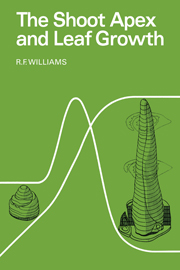2 - The quantitative description of growth
Published online by Cambridge University Press: 04 August 2010
Summary
‘If the rate of assimilation per unit area of leaf surface and the rate of respiration remain constant, and the size of the leaf system bears a constant relation to the dry weight of the whole plant, then the rate of production of new material, as measured by the dry weight, will be proportional to the size of the plant, i.e. the plant in its increase in dry weight will follow the compound interest law.’
‘The rate of interest, r, may be termed the efficiency index of dry weight production.’
‘It is clear…that the efficiency of the plant is greatest at first and then falls somewhat, but the fall is only slight until the formation of the inflorescence, when there is a marked diminution in the efficiency index.’
v. h. blackman (1919)Although it is commonly acknowledged that we owe to Blackman the first clear statement of the mathematical principles underlying the law of exponential growth, his ‘efficiency index’ has had an extraordinary history of criticism and rejection. The efficiency index is, of course, none other than the relative growth rate – a concept which has always been eminently respectable. No doubt the nature of the analogy – that of compound interest – and reference to it as a physiological constant are the bases of the misunderstandings. His earliest critics were Kidd et al. (1920) and they were effectively answered by Blackman (1920) in the same volume of the New Phytologist. Of special interest is the contention of Kidd et al. that the only way in which plants can be compared is by the comparison of the whole series of efficiency indices throughout their life-cycles.
- Type
- Chapter
- Information
- Shoot Apex and Leaf Growth , pp. 9 - 26Publisher: Cambridge University PressPrint publication year: 1975

